Published
on 6
Apr 2017
|
All rights reserved.
|
|
|
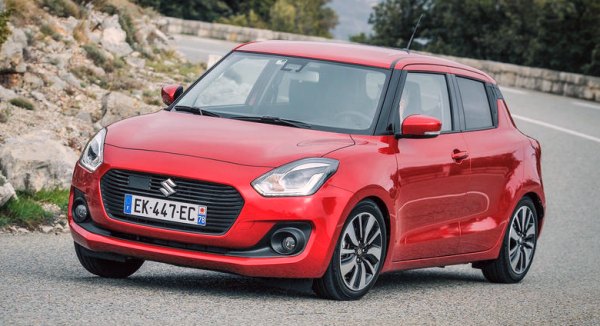 |
|
Its
evolutionary styling approach is so subtle that even Volkswagen might
struggle to match...
|
|
In
the past 12 years or so, European superminis got more and more oriented
to comfort, refinement, quality, safety and low emission, but
unfortunately also made themselves larger, heavier and more boring to
drive in the process. One car worked against this trend: Suzuki Swift.
If you compare the 2005, 2010 and 2017 models, you will find
them
remarkably close to each other. Its evolutionary styling approach is so
subtle that even Volkswagen might struggle to match. Its size grew a
little from 2005 to 2010, but then the latest generation stays almost
unchanged. If you put them on scale, you will even find the latest car
undercuts its predecessors by some margin. Time fails to leave any
signs on the face of Swift.
That makes the Swift an oddball in the European market though.
Measuring 3.840mm long, 1735mm wide and 1495mm tall, it is considerably
smaller than the norm of European B-segment superminis, which has
exceeded 4 meters in length long ago. However, if you judge the car
solely on size, you will be very wrong. Enter the cabin and you will
find the Swift actually quite accommodative – not as spacious as a
Skoda Fabia, of course, but it will sit a quartet of 6ft tall guys with
enough knee and headroom. Compared with the last generation, its
wheelbase stretch from 2430 to 2450mm helps in this respect, but
miraculously, boot space has increased from 211 to 265 liters
simultaneously, even though the rear overhang gets shorter!
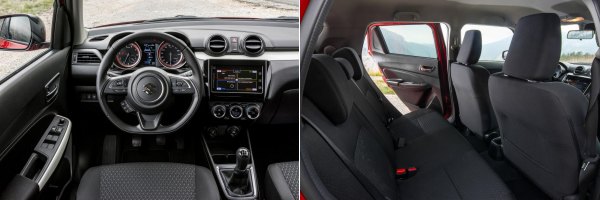 |
|
Small
outside, big inside. How can Suzuki manage that?
|
|
Yes,
the cabin looks Spartan compared with its European rivals. The Swift
has always been modest on material quality or switch tactility, because
it is not designed purely for European customers. A large portion of
its sales comes from developing markets like India and ASEAN countries
which demand practicality rather than frills. This explains why it is
built in India and Thailand beside Japan and Hungary – each supplies
the nearby region. However, while its cabin lacks showroom appeal, it
works just as fine in practice. Fit and finish of the assembly is as
good as any Japanese standards. The driver seat is supportive and
pretty comfortable, unlike the cheap seats that you would find in
Proton or Tata. Moreover, it is mounted low enough to give you a sporty
driving position. The steering, gearshift and clutch are nicely
weighted. It is very well equipped for the prices it asks, too,
although the infotainment system is rather cheap. If you ask what can
be improved, that would be more in-cabin storage spaces and some warmer
or more colourful trims instead of the dark theme. That said, the Swift
does not intend to be a Mini Cooper.
Compared with the last generation, the latest Swift has its exterior
design made more organic. The nose looks sleeker and more pronounced,
the fenders get more muscular while the tail looks more protrudent. The
rear door handles are “hidden” at the C-pillars as in Renault Clio (or
so many other cars these days), and the roof is made semi-floating by a
inserting a blackened portion at the C-pillar. Overall, it is a funky
and characterful design, though I still prefer the simpler and purer
lines of the old car.
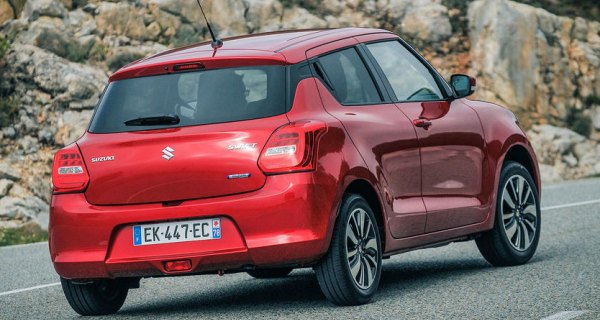 |
|
The
base Swift weighs only 840 kilograms, 135 less than VW Polo.
|
|
The latest
European superminis are enjoying weight saving thanks to the discovery
of high-strength steel, but that happens after they have already gained
100 or 150 kg in the last decade. This means, they have yet to return
to the kerb weight of their predecessors 2 generations ago. Unlike
them, Suzuki is really the expert of weight saving. The base Swift
weighs only 840 kilograms, 120 kg lighter than the last generation and
150 kg less than the 2005 model. Its rivals? The base VW Polo tips the
scale at 975 kg, ditto Peugeot 208. Most other rivals are heavier
still. How can Suzuki achieve that? Part of the answer lies on the
“Heartect” platform it shares with Balano and Ignis. Heartect saves
weight not only by using more high-strength steel but also resorts to
curvy longitudinal members and reduction of connecting points.
Admittedly, another reason is the company’s focus on weight reduction
over refinement. The Swift is not uncomfortable to travel along, but it
is not as quiet as most other European superminis, blame to the thinner
insulation materials and less structural steel and adhesives it used.
On highway, it lets more wind and tire noises to be heard in the cabin.
On broken surfaces, its suspension does not filter the bumps and
irregularities as well as many rivals, although its damping deals with
smoother undulations with ease.
On the flipside, its chassis keeps the sporty spirit of its
predecessors. Instead of the safe understeer that most of its rivals
prefer, it is tuned for agility. It feels lively and responsive to
steer from the straight ahead. The steering is light, quick but
accurate. Body roll is kept well checked in corners, where the car
grips and balances nicely. Don’t expect its alert steering to promote
highway stability, but this car will be fun to drive on back roads,
which is superminis all about. It should give the forthcoming Swift
Sport a solid starting point. Ford Fiesta still has the best handling,
but the Suzuki is not far off.
 |
|
Thankfully,
poor drivers can still find some fun in motoring.
|
|
With
less weight to haul, the Swift can carry over the old car’s 1.2 Dualjet
engine without any problems. Although it might lack modern technologies
– the only notable mention is dual injectors for the port injection, we
have no complaints to its sweet revving manner or its 91hp output,
which is good enough to register 112 mph and 0-60 in 11 seconds.
However, if you want higher performance and a more relaxing driving
manner, the Baleno’s 1.0 Boosterjet 3-cylinder direct injection turbo
will be a good answer, as it supplies 110 horsepower and 125 lbft of
mid-range torque. Like Ford’s 1.0 Ecoboost engine, it uses unbalanced
crankshaft and flywheel in combination with a better engine mount to
absorb the inherent vibration of 3-cylinder motor, so there is not much
to complain about refinement. It’s neither as strong nor as quiet as
Ford’s triple, but it is still a pretty good engine. Performance is
quoted at 121 mph and 10 seconds to do 0-60, but it could be a
conservative estimation considering its power-to-weight ratio. Both
engines could be added with SHVS mild
hybrid system to save fuel. It uses an ISG (integrated starter
generator) and a 0.37kWh lithium battery stored under the front
passenger seat to provide another 3hp and 37 lbft to relieve the
burden of the engine.
Sporty, quick, fun-looking, uncomplicated and cheap to buy have always
been the core values of Suzuki Swift. Thankfully, the new Swift has
kept these values intact so that poor drivers can still find some fun
in motoring.
|
Verdict:     |
Published
on 18
Apr 2018
|
All rights reserved.
|
|
Swift Sport
|
|
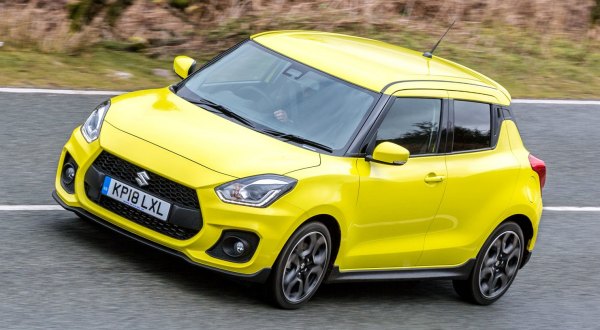
|
|
Suzuki's
great hot hatch is the latest victim of modernization.
|
|
Read the old report and
you will find the old Suzuki Swift Sport was in a stark contrast to the
new car. We praised the old car’s courage to keep a high-revving
naturally aspirated motor, a no-nonsense styling and an interactive
handling to make it affordable yet fun to drive in an old-school way.
The new car has lost many of these merits. For starters, the car’s
styling gets a bit odd and busy, not quite as pure and tasteful as
before. Then the big news is the “Boosterjet” 1.4-liter direct
injection turbo four-cylinder, which is modified from the one serving
Vitaria. Yes, its output figures are all advanced – horsepower is up
from 134 to 140, torque is massively increased from 118 to 170 lbft,
and it is now available from 2500-3500 rpm rather than the previous
4400 rpm. This changes the driving character of the car massively as
well, meaning you are prone to upshift earlier, relying on the
mid-range torque rather than rev to carry through bends.
As you no longer need to squeeze the engine, cruising refinement is
improved, too. On the flipside, the Swift Sport is no longer that
exciting to drive. Although the 6-speed manual gearbox still has a
sweet gearchange, you no longer experience that quite often. Although
the turbocharged engine shows little lag, its exhaust note is muted at
any rev. While the old motor revved sweetly towards its 7000 rpm
redline, accompanied with a throaty sound, the Boosterjet delivers no
rewards beyond 5500 rpm, and its rev limiter cuts oil at 6000 rpm
sharp. Consequently, the new Swift Sport is faster – 0-60 mph takes 7.6
seconds, 0.6 less than before, and top speed is lifted by 9 mph – and
it feels faster still, but the extra speed actually brings less thrill,
sadly, because you are less involved with the car through your arms,
feet, ears and brain.
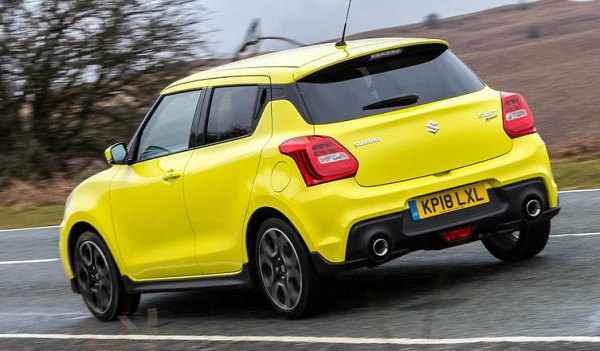
|
|
The
numb chassis fails to interact with its driver.
|
|
Maybe the chassis could claw back some lost points? Sharing the
lightweight platform with Baleno, the new car is 70 kg lighter than the
car it replaces, which is outstanding for a car so small. In fact, at
975kg, it is lighter than any cars in its class, including the smaller
Volkswagen Up GTi. Better still, the weight saving does not come at the
cost of rigidity or NVH suppression. The new Swift Sport rides slightly
smoother and quieter than the old car, and no worse than most hot
hatches on the market.
Meanwhile, body roll is well contained. As expected, it gets stiffer
suspension setup and higher performance dampers, 15mm lower ride height
and 40mm wider tracks than the regular Swift, accompanied with 17-inch
wheels shod with 195/45 rubbers. The steering is quite numb and heavy,
but the light car displays responsive turn-in, and the front-end grip
is strong. The progressive brake pedal makes heel-and-toe easy.
However, unlike the old car, this chassis feels numb at the limit. The
nose barely tucks in the slightest at throttle lift off. The tail never
steps out regardless of throttle and braking. Sorry, it has lost the
man-machine interaction of the old car, an essential requirement for
all the great little hot hatches such as Ford Fiesta ST, Peugeot 208GTi
and Mini Cooper. Sadly, the Suzuki becomes the latest victim of
“modernization”, at least from the viewpoint of keen drivers.
Meanwhile, the price of the new car has risen by a massive 25 percent,
getting uncomfortably close to those great rivals. All this means the
Swift Sport has lost its magic.
|
Verdict:    |
|